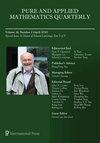广义相对论中的李-莱因哈特代数
IF 0.8
4区 数学
Q3 MATHEMATICS
引用次数: 5
摘要
我们在爱因斯坦方程初值域空间的无限小扩展上构造了一个Lie-Rinehart代数。该代数中的括号关系正是初值问题的约束关系。李-莱因哈特代数来自于李代数的一个轻微推广,在李代数中,代数由一个束的部分而不是一个向量束组成。(一个真正的李代数此前已经由Blohmann, Fernandes和Weinstein构造了一个更大的扩展。)该构造使用BV-BFV (Batalin-Fradkin-Vilkovisky)方法来解决边值问题,从爱因斯坦方程本身开始,在扩展初始数据的梯度流形上构造$L_\infty$ -代数体。然后通过变量的变换来构造Lie-Rinehart代数。BV-BFV方法的结果之一是证明了约束集的共同性性是由时空微分同态下爱因斯坦方程的不变性推导出来的。本文章由计算机程序翻译,如有差异,请以英文原文为准。
A Lie–Rinehart algebra in general relativity
We construct a Lie–Rinehart algebra over an infinitesimal extension of the space of initial value fields for Einstein’s equations. The bracket relations in this algebra are precisely those of the constraints for the initial value problem. The Lie–Rinehart algebra comes from a slight generalization of a Lie algebroid in which the algebra consists of sections of a sheaf rather than a vector bundle. (An actual Lie algebroid had been previously constructed by Blohmann, Fernandes, and Weinstein over a much larger extension.) The construction uses the BV–BFV (Batalin–Fradkin–Vilkovisky) approach to boundary value problems, starting with the Einstein equations themselves, to construct an $L_\infty$-algebroid over a graded manifold which extends the initial data. The Lie–Rinehart algebra is then constructed by a change of variables. One of the consequences of the BV–BFV approach is a proof that the coisotropic property of the constraint set follows from the invariance of the Einstein equations under space-time diffeomorphisms.
求助全文
通过发布文献求助,成功后即可免费获取论文全文。
去求助
来源期刊
CiteScore
0.90
自引率
0.00%
发文量
30
审稿时长
>12 weeks
期刊介绍:
Publishes high-quality, original papers on all fields of mathematics. To facilitate fruitful interchanges between mathematicians from different regions and specialties, and to effectively disseminate new breakthroughs in mathematics, the journal welcomes well-written submissions from all significant areas of mathematics. The editors are committed to promoting the highest quality of mathematical scholarship.

 求助内容:
求助内容: 应助结果提醒方式:
应助结果提醒方式:


